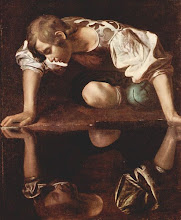 In the early 1600s Carlo Saraceni, inspired by Giorgio Vasari's Perseus and Andromeda, which we looked at in my previous post, produced the picture below of Andromeda in Chains, which is now in Dijon's Musée des Beaux-Arts, but not on their website.(the picture of coral on the left was produced by the United States National Oceanic and Atmpospheric Administration and is thus in the public domain. From wikicommons)
In the early 1600s Carlo Saraceni, inspired by Giorgio Vasari's Perseus and Andromeda, which we looked at in my previous post, produced the picture below of Andromeda in Chains, which is now in Dijon's Musée des Beaux-Arts, but not on their website.(the picture of coral on the left was produced by the United States National Oceanic and Atmpospheric Administration and is thus in the public domain. From wikicommons)
In 1610 Mozzarone painted a picture of Andromeda which is now in Florence's Uffizi Gallery.

Another similar painting by Joachim Wtewael shown above, dates from 1611 and is now in Paris's Louvre.



Rubens painted three versions of Perseus and Andromeda. The top picture is in St. Petersburg's State Hermitage while the middle picture is in Berlin's Gemälde Galerie Kulturforum, but not on their website. They were both painted in 1620 or 1621, while the bottom picture was one he was working on when he died in 1640 and is now in Madrid's Prado (direct link to picture not possible).
At about the same time as Rubens was painting the first two of his pictures of Perseus, Lully was composing an opera about Perseus and Andromeda: Persée, the opening of a recent TV production of which can be seen in the above embedded YouTube video. Other parts of this production are also available on YouTube.

Around 1630 Rembrandt painted the above picture, which is now in the Hague's Mauritshuis (scroll down).

The tapestry shown above was designed by Francis Cleyn and made from 1635-1645. It is now in London's Victoria and Albert Museum, but is not on their website.

The above 1679 painting by Pierre Mignard is now in Paris's Louvre.

Also in the Louvre are the above 1678-1684 statue of Perseus and Andromeda by Pierre Puget and a 1671 drawing by Claude Lorrain, depicting not Perseus's rescue of Andromeda but the creation of coral from seaweed by Medusa's head while Perseus is washing his hands in the sea after killing the monster. The drawing was preparation for the painting below, now in a private collection. (Picture of statue in the public domain according to museumsyndicate.com, picture below used under creative commons licence)

We'll finish this look at the 17th century with a 17th century copy of Guido Reni's 1635 Perseus and Andromeda in London's National Gallery (the original is in the Pallavicini collection in Rome, but not on their website) and a 1638 picture in the Los Angeles County Museum of Art, which may or may not be by Anthony van Dyck. It serves as the hook for this article from the Los Angeles Times on the re-attribution of works of art. (pictures not otherwise credited are in the public domain and come from wikicommons)





1 comment:
Stunning
Post a Comment